By Leen Randell
Updated: Jul 19, 2024
10 Best Herbal Creams For Muscle Pain
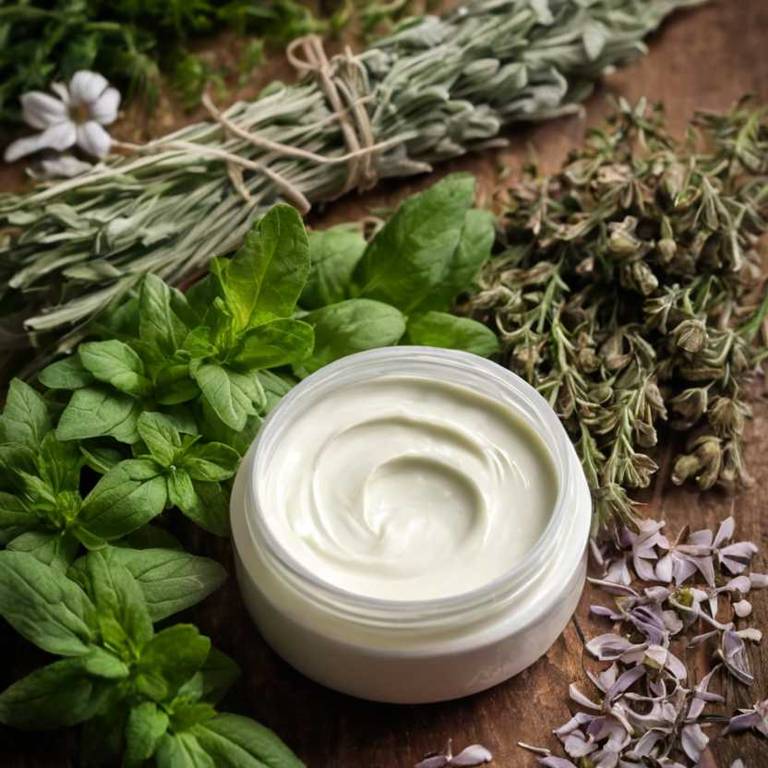
Herbal creams for muscle pain are topical treatments infused with natural herbs and essential oils that help alleviate muscle soreness and inflammation.
These creams, often made with ingredients like arnica, peppermint, and ginger, work by reducing pain and inflammation, promoting relaxation and improving circulation.
Examples include creams containing turmeric, capsaicin, and willow bark, which have been shown to improve sleep quality, reduce stiffness, and enhance daily activities, ultimately improving overall quality of life and well-being.
The following article describes in detail the most important creams for muscle pain, including medicinal properties, parts of herbs to use, and recipes for preparations.
- 1. Arnica montana
- 2. Capsicum annuum
- 3. Salix alba
- 4. Glycyrrhiza glabra
- 5. Camellia sinensis
- 6. Echinacea angustifolia
- 7. Rhus aromatica
- 8. Calendula officinalis
- 9. Hypericum perforatum
- 10. Viburnum opulus
- What is the best combination of herbal creams to use for muscle pain?
- What ailments similar to muscle pain are treated with herbal creams?
1. Arnica montana
Arnica montana, also known as mountain arnica, creams helps with muscle pain because of its anti-inflammatory properties.
The plant's active compounds, such as sesquiterpene lactones, have been shown to reduce swelling and ease pain in affected areas.
Topical application of Arnica montana cream allows these compounds to penetrate the skin, directly targeting the source of pain and inflammation, providing relief from sore muscles, sprains, and strains, making it a popular natural remedy for athletes and individuals with physically demanding lifestyles.
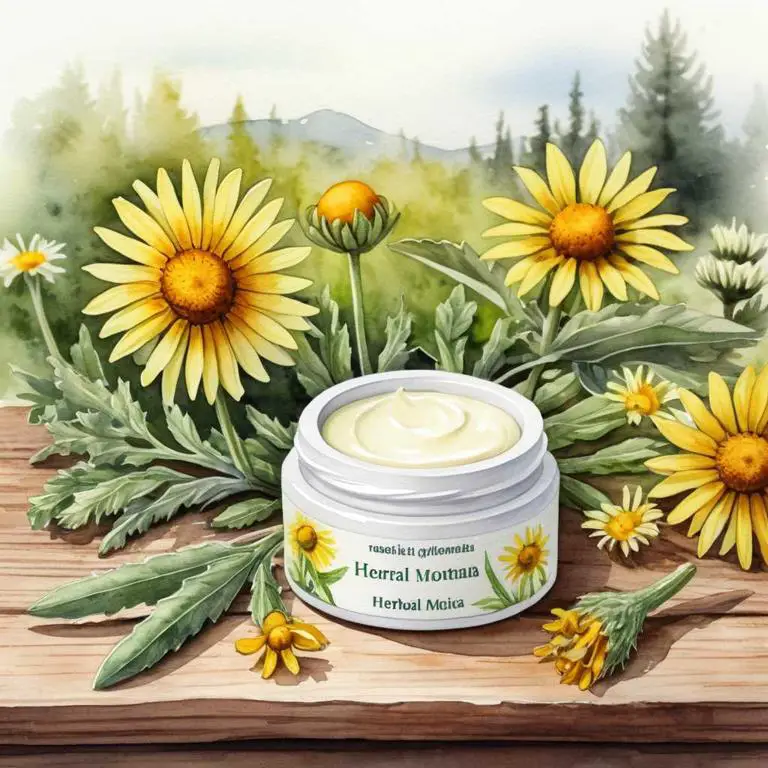
Medicinal Constituents
The list below shows the primary medicinal constituents in Arnica montana creams that help with muscle pain.
- Tremulides: These sesquiterpene lactones exhibit anti-inflammatory properties, helping to reduce pain and swelling associated with muscle injuries.
- Arnidiol: A sesquiterpene lactone with analgesic and anti-inflammatory properties, arnidiol helps to alleviate muscle pain and reduce inflammation in affected areas.
- Helenalin: A sesquiterpene lactone, helenalin has anti-inflammatory and analgesic properties, contributing to its pain-relieving effects in muscle pain and inflammation.
Parts Used
The list below shows the primary parts of mountain arnica used to make creams for muscle pain.
- Flowers: The flowers of Arnica montana are used to make creams for muscle pain because they contain a high concentration of sesquiterpene lactones, which have anti-inflammatory and pain-relieving properties.
- Leaves: The leaves of Arnica montana are used to make creams for muscle pain because they contain compounds that help reduce inflammation and promote healing.
- Buds: The buds of Arnica montana are used to make creams for muscle pain because they contain sesquiterpene lactones that have analgesic and anti-inflammatory effects.
Quick Recipe
The following recipe gives a procedure to make a basic mountain arnica for muscle pain.
- Gather 30g of dried arnica montana flowers and 200ml of base cream.
- Combine the dried arnica montana flowers with 200ml of a carrier oil in a double boiler.
- Steep the mixture for 2-3 hours or overnight then strain and discard the solids.
- Mix 10g of beeswax with 50g of the infused oil in a saucepan over low heat.
- Blend the mixture with 20g of vitamin e oil and 20g of a base cream in a bowl.
2. Capsicum annuum
Capsicum annuum, also known as bell pepper, creams helps with muscle pain because of its active compound, capsaicin.
Capsaicin works by blocking the production of a chemical called substance P, which transmits pain signals to the brain. As a result, capsaicin reduces the sensation of pain and inflammation in the affected area.
When applied topically, capsaicin creams can provide fast and effective relief from muscle and joint pain, making it a popular natural remedy for athletes and individuals suffering from chronic pain.
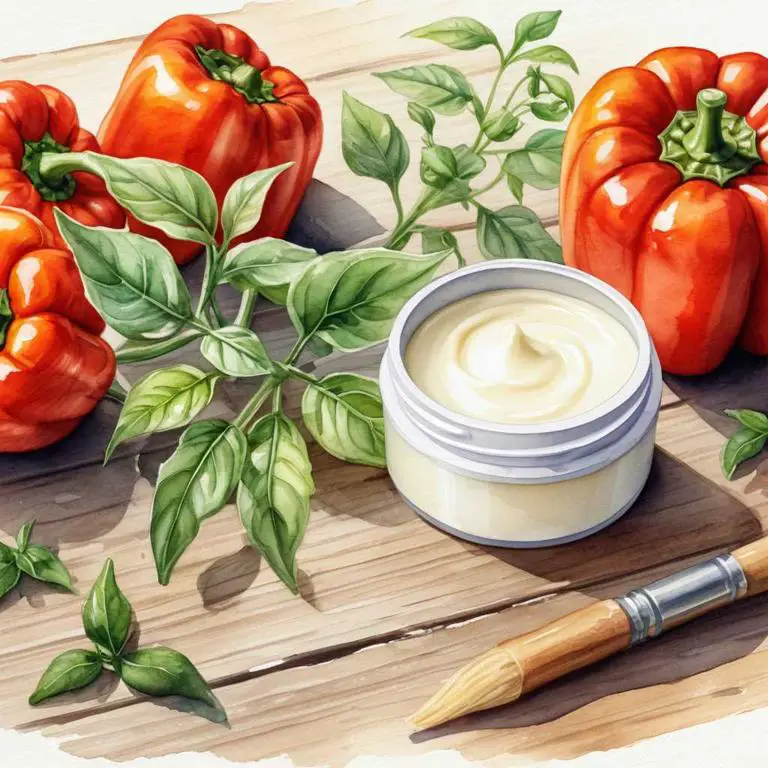
Medicinal Constituents
The list below shows the primary medicinal constituents in Capsicum annuum creams that help with muscle pain.
- Capsaicin: Capsaicin is a potent analgesic compound that helps to relieve muscle pain by blocking the production of a chemical called substance P, which transmits pain signals to the brain.
- Catechins: Catechins are a type of polyphenolic compound found in Capsicum annuum that have anti-inflammatory and antioxidant properties, helping to reduce inflammation and alleviate muscle pain.
- Flavonoids: Quercetin is a flavonoid found in Capsicum annuum that has potent anti-inflammatory and antioxidant properties, which help to reduce muscle inflammation and pain.
Parts Used
The list below shows the primary parts of bell pepper used to make creams for muscle pain.
- Fruits: They contain capsaicin, a natural analgesic compound that helps to reduce pain and inflammation.
- Leaves: They have a lower concentration of capsaicin compared to fruits but are still used in some products, often in combination with other ingredients.
- Seeds: They contain a higher concentration of capsaicin than leaves but are more commonly used in hot sauces than in creams for muscle pain.
Quick Recipe
The following recipe gives a procedure to make a basic bell pepper for muscle pain.
- Harvest 10-12 fresh capsicum annuum fruits when they are fully ripe and have a deep red color.
- Dry the capsicum annuum fruits in a warm place at 40-50 degrees celsius for 2-3 days.
- Grind the dried capsicum annuum fruits into a fine powder using a coffee grinder.
- Mix the ground capsicum annuum powder with 100 grams of beeswax and 100 grams of coconut oil in a double boiler.
- Stir the mixture continuously for 10-15 minutes until it turns into a smooth and creamy texture.
3. Salix alba
Salix alba, also known as white willow, creams helps with muscle pain because it contains salicin, a natural compound similar to aspirin.
When applied topically, salicin is absorbed into the skin and muscles, where it reduces inflammation and blocks pain-causing chemicals. This results in a decrease in muscle discomfort, stiffness, and soreness, making it an effective natural remedy for post-exercise pain, arthritis, and other muscle-related issues.
The anti-inflammatory properties of Salix alba creams provide long-lasting relief and promote overall muscle health.
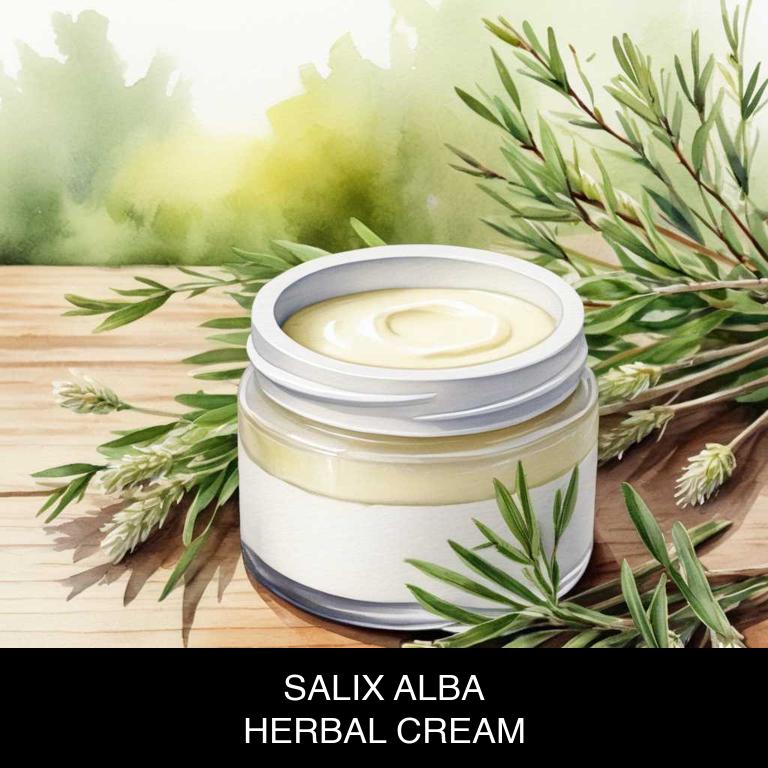
Medicinal Constituents
The list below shows the primary medicinal constituents in Salix alba creams that help with muscle pain.
- Salicin: A glycosidic compound that acts as a pain reliever and anti-inflammatory agent, helping to reduce muscle pain and inflammation.
- Salicylic acid: A phenolic compound that has anti-inflammatory, analgesic, and anti-pyretic properties, which contribute to its muscle pain-relieving effects.
- Triterpenoid saponins: A type of compound that has anti-inflammatory, antioxidant, and analgesic properties, helping to reduce muscle pain and inflammation.
Parts Used
The list below shows the primary parts of white willow used to make creams for muscle pain.
- Barks: Used due to their high content of salicin, a compound similar to aspirin that helps reduce inflammation and pain.
- Leaves: Utilized for their salicin content, which provides anti-inflammatory and analgesic properties.
- Stems: Employed for their bark content, which contains salicin and helps alleviate muscle pain and inflammation.
Quick Recipe
The following recipe gives a procedure to make a basic white willow for muscle pain.
- Harvest 1/2 pound of dried salix alba bark at a local botanical garden or with permission from a landowner.
- Infuse 2 cups of water with 2 tablespoons of dried salix alba bark in a saucepan over low heat.
- Steep the mixture for 10-15 minutes or until the liquid has reduced to 1 cup.
- Strain the liquid through a cheesecloth or fine-mesh sieve into a clean glass bowl.
- Mix 1/2 cup of beeswax with 1/4 cup of coconut oil and 1/4 cup of the strained salix alba infusion in a double boiler.
4. Glycyrrhiza glabra
Glycyrrhiza glabra, also known as licorice, creams helps with muscle pain because of its anti-inflammatory properties.
The active compound glycyrrhizin in licorice root has been shown to reduce swelling and inflammation in the body, which can help to alleviate muscle pain and discomfort. Additionally, licorice creams often contain other soothing ingredients such as aloe vera and chamomile, which can help to calm and relax the muscles, providing relief from tension and pain.
This natural remedy can be a useful alternative for managing muscle pain.

Medicinal Constituents
The list below shows the primary medicinal constituents in Glycyrrhiza glabra creams that help with muscle pain.
- Licorice saponins: These compounds have anti-inflammatory properties that help reduce muscle inflammation and alleviate pain.
- Glycyrrhizin: This triterpenoid saponin helps block the production of a hormone called cortisol, which can contribute to muscle inflammation and pain when produced in excess.
- Flavonoids: These polyphenolic compounds have potent anti-inflammatory and antioxidant effects, which help reduce muscle damage and alleviate pain.
Parts Used
The list below shows the primary parts of licorice used to make creams for muscle pain.
- Roots: They contain glycyrrhizin, a compound with anti-inflammatory properties that helps to reduce pain and inflammation in muscles.
- Leaves: They also contain glycyrrhizin, which has analgesic and anti-inflammatory effects that can help to soothe muscle pain.
- Barks: The barks of the plant contain a combination of compounds that provide anti-inflammatory and antioxidant effects, helping to reduce muscle pain and promote relaxation.
Quick Recipe
The following recipe gives a procedure to make a basic licorice for muscle pain.
- Infuse 1:2 ratio of dried glycyrrhiza glabra roots in 250ml of carrier oil like jojoba oil for 2 weeks.
- Strain the infused oil through a cheesecloth into a clean container discarding the solids.
- Weigh 20% of the total mixture and add 1g of beeswax to the glycerin mixture.
- Heat the beeswax mixture in a double boiler until the beeswax melts and blends.
- Allow the cream to cool and thicken before transferring it to a clean container for storage.
5. Camellia sinensis
Camellia sinensis, also known as tea, creams helps with muscle pain because of its anti-inflammatory and antioxidant properties.
The herbal extract from Camellia sinensis is rich in flavonoids, which help to reduce inflammation and soothe sore muscles. The cream's cooling sensation can also provide relief from muscle tension and spasms.
Additionally, its moisturizing properties promote healthy skin and aid in the healing process, making it an effective topical solution for alleviating muscle pain and promoting overall well-being.
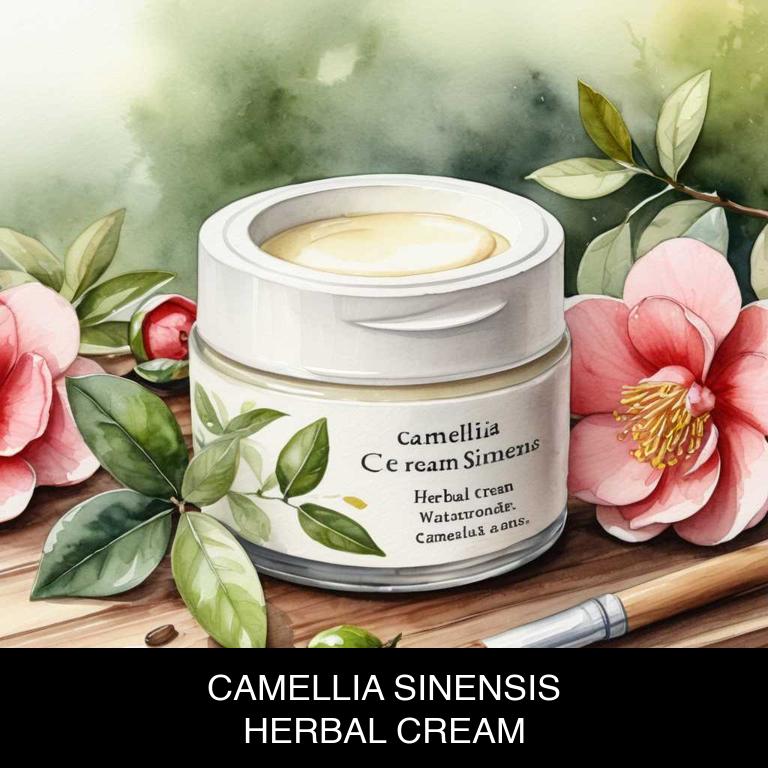
Medicinal Constituents
The list below shows the primary medicinal constituents in Camellia sinensis creams that help with muscle pain.
- Theaflavans: These polyphenolic compounds have potent anti-inflammatory and antioxidant properties, which help to reduce muscle pain and inflammation by inhibiting the production of pro-inflammatory enzymes.
- Catechins: Specifically, epigallocatechin gallate (EGCG), a catechin found in Camellia sinensis, has been shown to have analgesic and anti-inflammatory effects, which help to relieve muscle pain and reduce inflammation.
- Quercetin: This flavonoid has potent anti-inflammatory and antioxidant properties, which help to reduce muscle pain and inflammation by inhibiting the production of pro-inflammatory enzymes and reducing oxidative stress.
Parts Used
The list below shows the primary parts of tea used to make creams for muscle pain.
- Leaves: Camellia sinensis leaves are widely used in muscle pain creams due to their high content of caffeine and catechins, which help reduce inflammation and relieve muscle tension.
- Roots: Camellia sinensis roots are also used in muscle pain creams because they contain compounds that help reduce inflammation and pain, as well as promote relaxation.
- Barks: Camellia sinensis barks are sometimes used in muscle pain creams for their analgesic and anti-inflammatory properties, which help alleviate muscle pain and discomfort.
Quick Recipe
The following recipe gives a procedure to make a basic tea for muscle pain.
- Harvest 100g of camellia sinensis leaves by hand during early morning hours when the dew is still present.
- Steep 50g of the harvested leaves in 500ml of boiling water for 5-7 minutes to create a strong infusion.
- Combine 200g of distilled water with 50g of glycerin and 10g of beeswax in a double boiler.
- Gradually add the steeped camellia sinensis infusion to the mixture in the double boiler and stir until the beeswax is fully dissolved.
- Pour the mixture into glass jars and allow it to cool and solidify before use.
6. Echinacea angustifolia
Echinacea angustifolia, also known as Kansas coneflower, creams helps with muscle pain because it contains anti-inflammatory compounds that reduce swelling and alleviate discomfort.
The cream's active ingredients, such as alkylamides and phenolic acids, work to block pain receptors and relax tense muscles. Regular application can also improve circulation, helping to speed up the healing process and reduce muscle stiffness.
By promoting relaxation and reducing inflammation, Echinacea angustifolia creams provide effective relief from muscle pain and promote overall well-being.
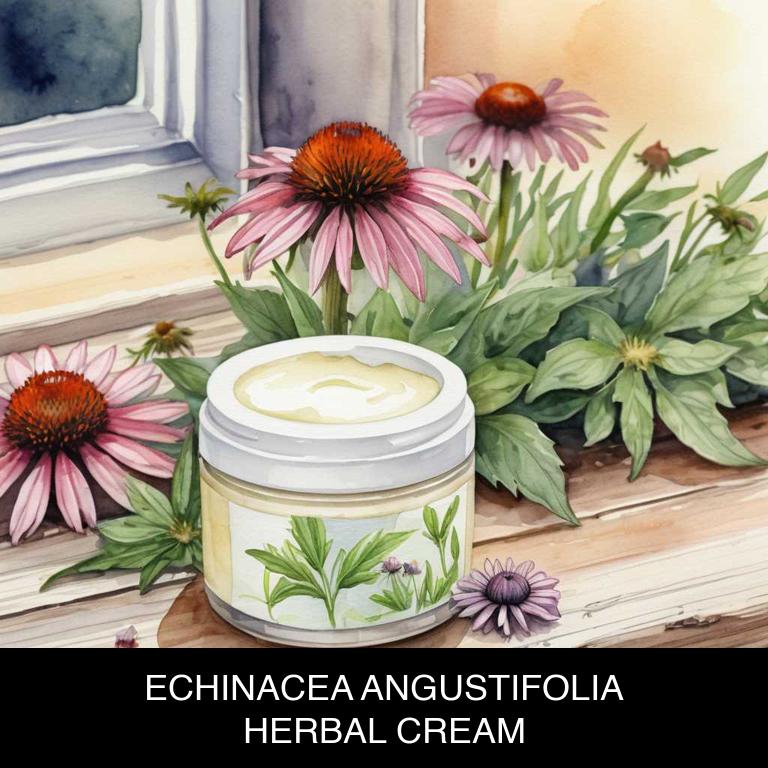
Medicinal Constituents
The list below shows the primary medicinal constituents in Echinacea angustifolia creams that help with muscle pain.
- Iridoids: Iridoids, such as echinacoside, help reduce muscle pain by inhibiting the production of pro-inflammatory compounds and promoting relaxation in the affected area.
- Alkylamides: Alkylamides, including cis- and trans-cichoric acid, exhibit analgesic and anti-inflammatory properties, which help alleviate muscle pain by reducing inflammation and discomfort.
- Phenylpropanoids: Phenylpropanoids, such as caffeic acid and its derivatives, possess anti-inflammatory and antioxidant properties, which help mitigate muscle pain by reducing inflammation and oxidative stress.
Parts Used
The list below shows the primary parts of kansas coneflower used to make creams for muscle pain.
- Roots: Roots are the primary source of echinacoside, a compound responsible for the plant's analgesic and anti-inflammatory properties.
- Leaves: Leaves are used due to their high concentration of flavonoids, which have antioxidant and anti-inflammatory effects that help alleviate muscle pain.
- Stems: Stems are another commonly used part, containing compounds like alkylamides that have a soothing and relaxing effect on the body, reducing muscle tension and pain.
Quick Recipe
The following recipe gives a procedure to make a basic kansas coneflower for muscle pain.
- Harvest echinacea angustifolia roots in late fall when the tops have died back and the roots are fully developed.
- Dry the harvested roots in a single layer on paper bags for 7-10 days in a warm dry place.
- Grind 1 part dried root into a fine powder using a coffee grinder or mortar and pestle for 2-3 minutes.
- Mix 1 part powdered root with 1 part beeswax and 1 part coconut oil in a double boiler for 10-15 minutes.
- Whip the mixture with a hand mixer until it thickens and forms a smooth, spreadable cream.
7. Rhus aromatica
Rhus aromatica, also known as fragrant sumac, creams helps with muscle pain because of its anti-inflammatory and analgesic properties.
The cream contains compounds like rhus toxicodendron and rhus aromatica, which work together to reduce inflammation and alleviate pain in the affected muscles.
Regular application of the cream has been shown to provide relief from muscle aches, stiffness, and soreness, making it a popular natural remedy for individuals experiencing muscle strain or overuse injuries.
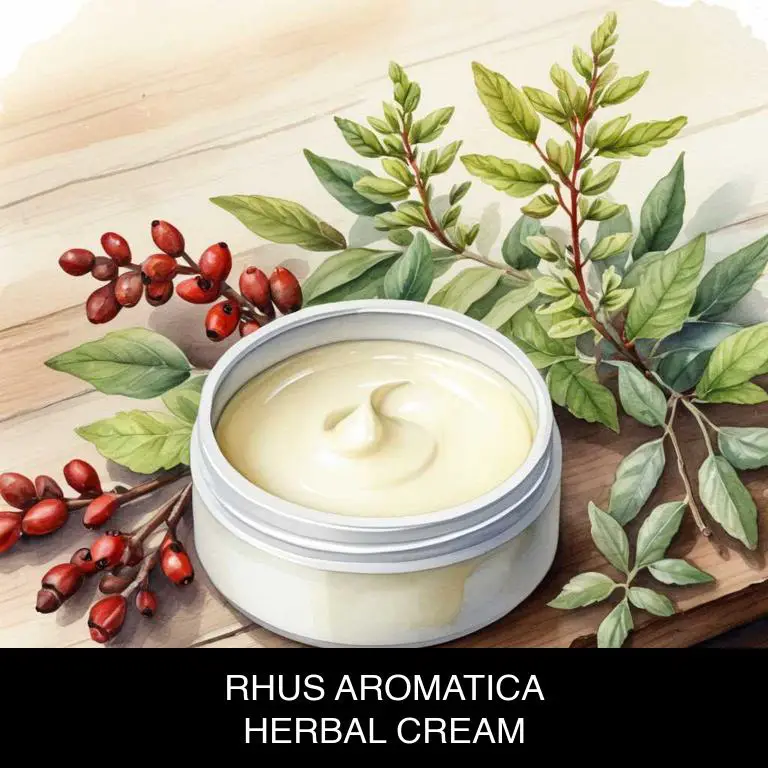
Medicinal Constituents
The list below shows the primary medicinal constituents in Rhus aromatica creams that help with muscle pain.
- Tannins: Tannins have anti-inflammatory properties that help reduce swelling and pain in muscles by inhibiting the production of pro-inflammatory enzymes.
- Flavonoids: Flavonoids, particularly quercetin, have potent anti-inflammatory and antioxidant effects that help alleviate muscle pain by reducing inflammation and oxidative stress in muscle tissues.
- Glycosides: Glycosides have anti-inflammatory and analgesic properties that help reduce pain and inflammation in muscles by inhibiting the production of pain-causing chemicals.
Parts Used
The list below shows the primary parts of fragrant sumac used to make creams for muscle pain.
- Leaves: Leaves are commonly used due to their high content of aromatic compounds that have anti-inflammatory and analgesic properties.
- Barks: Barks are used for their antioxidant and anti-inflammatory properties, which help to reduce pain and inflammation in muscles.
- Roots: Roots are used due to their high content of bioactive compounds that have anti-inflammatory and pain-relieving properties, making them suitable for muscle pain creams.
Quick Recipe
The following recipe gives a procedure to make a basic fragrant sumac for muscle pain.
- Gather 30g of dried rhus aromatica roots and 250ml of carrier oil such as sweet almond oil in a clean environment.
- Infuse the dried rhus aromatica roots in the carrier oil for 4 to 6 weeks in a cool dark place.
- Strain the infused oil through a cheesecloth into a clean container and discard the solids after 2 hours.
- Mix 10g of beeswax and 10g of candelilla wax with 100ml of the infused oil in a double boiler and heat until melted after 30 minutes.
- Allow the mixture to cool and solidify for 2 hours then use an immersion blender to whip until smooth and creamy.
8. Calendula officinalis
Calendula officinalis, also known as pot marigold, creams helps with muscle pain because of its anti-inflammatory and analgesic properties.
The plant's flavonoids, saponins, and terpenoids work together to reduce swelling and ease pain in the affected areas. The cream also promotes skin health and can help to soothe and calm irritated tissues, making it an effective solution for relieving muscle tension and discomfort.
This makes it a popular choice for athletes and individuals who engage in strenuous physical activity.

Medicinal Constituents
The list below shows the primary medicinal constituents in Calendula officinalis creams that help with muscle pain.
- Triterpenoids: These compounds help reduce inflammation and pain by inhibiting the production of pro-inflammatory enzymes and mediators.
- Flavonoids: Specifically, flavonoids like quercetin and kaempferol have anti-inflammatory and antioxidant properties, which help alleviate muscle pain and swelling.
- Phenylpropanoids: These compounds, including phenolic acids and glycosides, exhibit anti-inflammatory and analgesic activities, which contribute to the pain-relieving effects of Calendula creams.
Parts Used
The list below shows the primary parts of pot marigold used to make creams for muscle pain.
- Flowers: They contain anti-inflammatory and analgesic properties that help soothe and calm muscle pain.
- Leaves: They have anti-inflammatory and antioxidant properties that contribute to reducing muscle inflammation and promoting recovery.
- Stems: Although less commonly used than flowers and leaves, the stems also contain anti-inflammatory compounds that can help alleviate muscle pain.
Quick Recipe
The following recipe gives a procedure to make a basic pot marigold for muscle pain.
- Harvest 1 cup of calendula flowers in full bloom on a sunny day when they are free of dew.
- Dry the calendula flowers in a low-temperature oven at 150 degrees fahrenheit for 2 hours.
- Infuse 1 cup of dried calendula flowers in 2 cups of carrier oil such as coconut oil for 2 weeks.
- Strain the infused oil through a cheesecloth into a clean glass container and discard the solids.
- Mix the infused oil with 1/4 cup of beeswax and 2 tablespoons of shea butter to create a smooth cream.
9. Hypericum perforatum
Hypericum perforatum, also known as St John's Wort, creams helps with muscle pain because of its anti-inflammatory and analgesic properties.
The active compounds, such as hyperforin and hypericin, work to reduce pain and inflammation in the affected area. This natural remedy has been used for centuries to alleviate muscle and joint discomfort, making it a popular choice among individuals seeking a natural alternative to conventional pain relief methods.
Regular application can provide long-lasting relief and improved mobility.

Medicinal Constituents
The list below shows the primary medicinal constituents in Hypericum perforatum creams that help with muscle pain.
- Naphthodianthrones: These constituents, specifically hyperforin and hypericin, have potent anti-inflammatory and analgesic properties, helping to reduce muscle pain and inflammation.
- Flavonoids: Quercetin, a flavonoid found in Hypericum perforatum, has anti-inflammatory and antioxidant effects that help alleviate muscle pain and reduce inflammation.
- Phenolic acids: Rutin, a phenolic acid in Hypericum perforatum, has anti-inflammatory and antioxidant properties that help reduce muscle pain and inflammation by inhibiting the production of pro-inflammatory enzymes.
Parts Used
The list below shows the primary parts of st john's wort used to make creams for muscle pain.
- Leaves: They contain flavonoids and tannins that help reduce inflammation and relieve muscle pain.
- Flowers: They are rich in hyperforin, a compound that has analgesic and anti-inflammatory properties, making them effective in treating muscle pain.
- Stems: They contain a combination of flavonoids and phenolic acids that help to reduce inflammation and relieve muscle spasms.
Quick Recipe
The following recipe gives a procedure to make a basic st john's wort for muscle pain.
- Harvest 100g of dried hypericum perforatum flowers from a trusted source and ensure their quality and purity.
- Infuse 50g of the dried flowers in 500ml of carrier oil such as jojoba oil for 2 weeks.
- Strain the infused oil through cheesecloth or a coffee filter into a clean container discard the solids.
- Mix 20g of the infused oil with 10g of beeswax and 10g of shea butter in a double boiler.
- Heat the mixture over low heat for 10 minutes then let it cool and solidify into a smooth cream.
10. Viburnum opulus
Viburnum opulus, also known as guelder rose, creams helps with muscle pain because of its anti-inflammatory properties.
The cream contains salicin, a compound similar to aspirin, which helps to reduce inflammation and alleviate pain. The natural analgesic and anti-spasmodic properties of Viburnum opulus also make it effective in soothing sore muscles and joints.
Additionally, its antioxidant properties help to promote healing and reduce muscle fatigue, making it a popular choice for athletes and individuals suffering from muscle strain or overuse injuries.
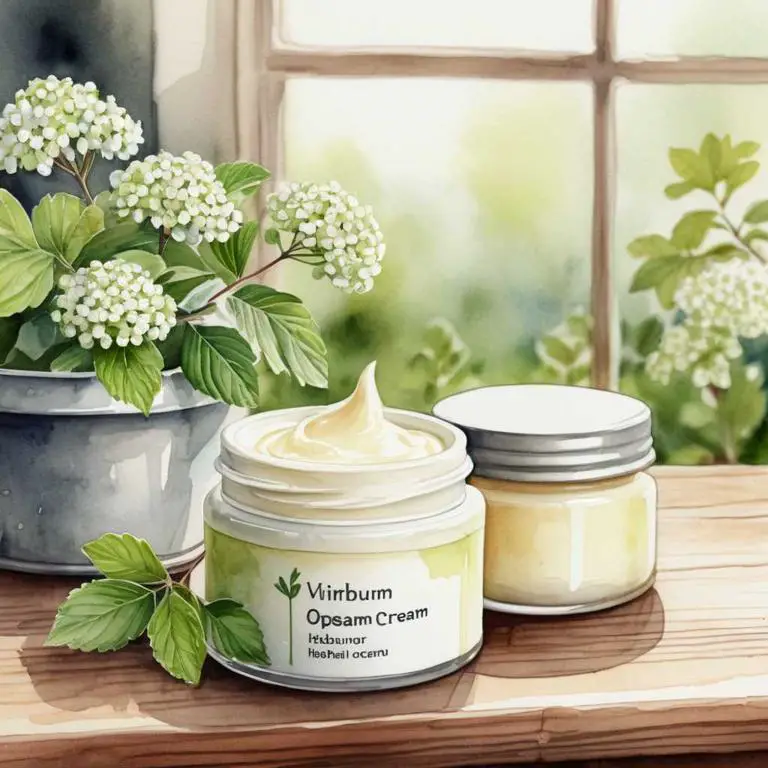
Medicinal Constituents
The list below shows the primary medicinal constituents in Viburnum opulus creams that help with muscle pain.
- Aucubin: Aucubin has anti-inflammatory properties, which help in reducing muscle pain and swelling by inhibiting the production of pro-inflammatory enzymes.
- Viburnin: Viburnin has a mild analgesic effect, which helps in numbing the pain and providing relief from muscle aches.
- Salidroside: Salidroside has anti-inflammatory and antioxidant properties, which help in reducing muscle pain and inflammation by protecting the cells from oxidative damage and promoting tissue repair.
Parts Used
The list below shows the primary parts of guelder rose used to make creams for muscle pain.
- Leaves: They contain iridoid glycosides and other compounds that have anti-inflammatory and analgesic properties, making them effective for treating muscle pain.
- Fruits: The fruits of Viburnum opulus, also known as guelder rose, contain anthocyanins and other compounds that have anti-inflammatory and antioxidant properties, which can help soothe and relieve muscle pain.
- Barks: The bark of Viburnum opulus contains glycosides and other compounds that have anti-inflammatory and analgesic properties, making it useful for treating muscle and joint pain.
Quick Recipe
The following recipe gives a procedure to make a basic guelder rose for muscle pain.
- Harvest 20g of dried viburnum opulus flowers and leaves to be used in the cream recipe.
- Steep the dried plant material in 200ml of carrier oil such as sweet almond oil for 2 weeks.
- Strain the oil mixture through a cheesecloth into a clean container to separate solids from liquid.
- Mix 100g of beeswax with 100g of shea butter and 20g of vitamin e oil in a double boiler.
- Combine the infused oil with the beeswax mixture and heat until fully incorporated and smooth.
What is the best combination of herbal creams to use for muscle pain?
The best combination of herbal creams that help with muscle pain is a blend of arnica, peppermint, and lavender.
Arnica reduces inflammation and promotes healing, while peppermint cools and relaxes the muscles. Lavender, with its calming properties, further soothes the pain and promotes a good night's sleep. Applying a mixture of these creams, either separately or combined, can provide long-lasting relief from muscle aches and discomfort.
This natural remedy is a great alternative to pain medications and promotes overall well-being.
What ailments similar to muscle pain are treated with herbal creams?
Ailments similar to muscle pain that are treated with herbal creams are joint pain, arthritis, and skin irritations.
Herbal creams containing ingredients like arnica, capsaicin, and menthol can help alleviate symptoms such as inflammation, redness, and itching associated with these conditions.
They can also provide relief from chronic conditions like fibromyalgia and tendonitis by reducing discomfort, stiffness, and pain.